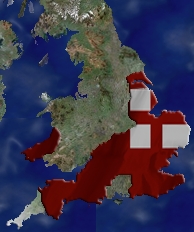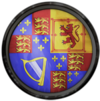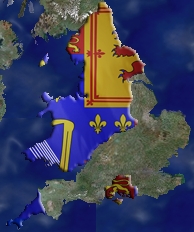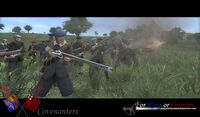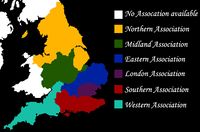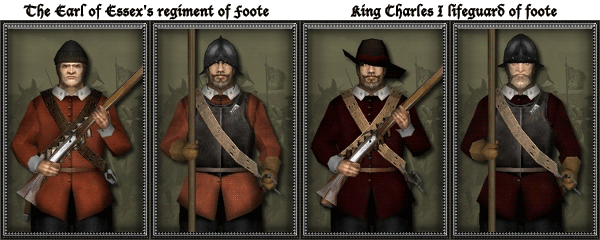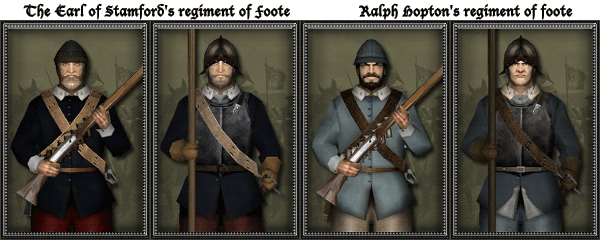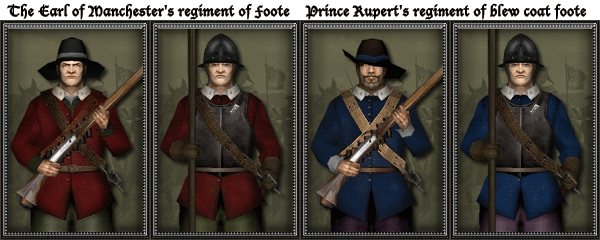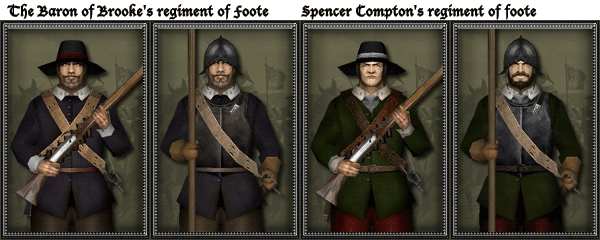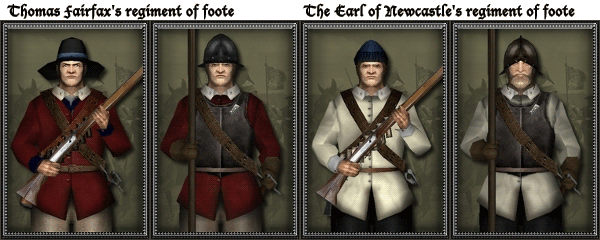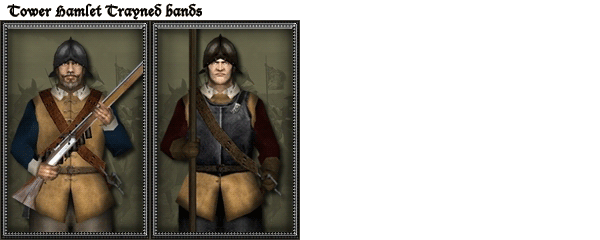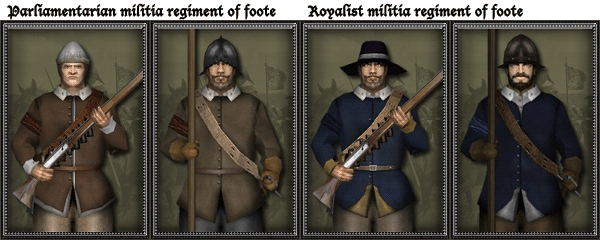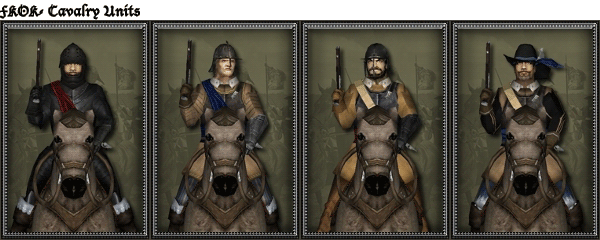For King or Country
Description
For King or Country is a modification for Medieval 2: Total War that depicts the English Civil Wars. There are two factions; the Roundheads (Parliament) and the Royalists. The map is detailed and accurate for the time period. There are twelve historical commanders fighting on each side, and all of them have custom portraits and traits. Both sides have a range of units from Musketeers to Pikemen, Dragoons to Harqebusier Cavalry. Each faction also has 6 unique recruitable regiments of foot. Each regiment has it's own banner, coat colour and commander.
The purpose of the mod is to simulate the first English Civil War. The main aim is to accurately represent the two main factions, their leaders, their commanders and their armies. The mod aims to provide a unique battlefield experience by representing 17th century warfare, something that no M2:TW mod team has so far achieved.
The campaign map is unique in that rather than having 'regions' or 'provinces' there are historically accurate counties. Each county has a single settlement. Faction generals are accurately placed according to their historical location in 1642 and represented with custom portraits and regiments.
Features
Factions
For King or Country focuses on the struggle between the two main factions involved in the English Civil War, Parliament and the Royalists. Each factions has a roster comprising of Pikemen, Musketeers, Artillery, Dragoons and Cavalry.
Parliament
- The year is 1642 and the bond that has exisisted between the King and his Parliament since the signing of the Magna Carta in 1215 has been shattered. War has now decended upon the realm with brother fighting brother, fathers fighting sons, nephews fighting uncles and the King fighting Parliament. The future looks grim and uncertain for the people of the British isles as their countries have decended into the chaos of Civil War. However one thing is certain, the victor will either be King Charles Stewart and his Royalist supporters or the men of Parliament with their supporters.
- Parliament and the country has suffered for too long under the tyrannical reign on King Charles. He has not only married a French Catholic but he has also dissolved parliament out of his own frustration, caused the Scots to rebel two years earlier in 1640 and worst of all, in January of this year he marched with 400 soldiers into our sacred House of Commons and demended the arrest of five of our members charged with treason. We now have little choice but to use military force in order to persuade Charles to listen to and respect the will of the common people through Parliament. He will not be an easy enemy to fight. The King holds support in much of the north, Wales, the west-country and Cornwall. However we hold London, the midlands and much of the east and I am confident of a swift victory for Parliament! May the Lord God bless us with victory and may he give the King enough sense to listen in the coming months, before too many of our fellow countrymen are killed.
- The origins of the English Civil war was born out of a series of disputes between King Charles I and his Parliament dating back to his coronation in 1625. Parliament was first concerned about Charles's marriage to the French Catholic princess Henrietta-Marie de Bourbon meaning that any heir could rule as a Catholic. Charles had also become infuriated with Parliament after they had refused him tax to pay for Charles's foreign policy ambitions, especially his military ambitions to sent English armies to the 30 years war. The initial spark for civil war came in 1637 when Scotland effectively rebelled in what became known as the Bishops War. Charles was forced to accept Scotland's rights to keep their religious traditions only after his army was defeated by the Covenanters at the battle of Newburn and Newcastle was captured in 1640. Parliament and the King eventually came to blows in January 1642 when Carles attempted to arrest five members of parliament on the charge of treason. When Charles failed he fled with his supporters and family to Oxford and between January and August of that year the towns and communities of England announced who they supported, with much of the west, Wales and the north declaring loyalty to the King. The first pitched battle was at Edgehill in October 1642 which resulted in both sides claiming a victory.
- The war would drag on untill 1651 claiming nearly one million lives, many of those dying from disease, famine and particularly in Ireland from religious genocide. On the 30th January 1649 King Charles I was lead out from Whitehall Palace onto a scaffold. He was then beheaded for high treason against the realm and people. His son (the future Charles II) would continue the war untill 1651 untill he was defeated at Worcester and fled to France. Charles II returned to London in 1660 with popular support. He was crowned in May 1661 and sentenced to death the surviving men who had voted to execute his father. However never again in British history would a monarch dare to confront Parliament, the face of Britain would be changed for ever.
- It is now up to you to match Parliaments victory and lead the roundheads to victory over the Royalists and King Charles.
Royalists
- The year is 1642 and the bond that has exisisted between the King and his Parliament since the signing of the Magna Carta in 1215 has been shattered. War has now decended upon the realm with brother fighting brother, fathers fighting sons, nephews fighting uncles and the King fighting Parliament. The future looks grim and uncertain for the people of the British isles as their countries have decended into the chaos of Civil War. However one thing is certain, the victor will either be King Charles Stewart and his Royalist supporters or the men of Parliament with their supporters.
- It is dispicable that Parliament refuse to accept the divine will of our great and noble King Charles. Parliament have been given a sound oppertunity to listen to the will of our King yet they have chosen to ignore his will and as a result they have jeapordized our position as a force in Europe and worst of all they have committed high treason. Parliament will regrette allowing the five condemned Members of Parliement to escape justice, it is only a matter of time before they beg for forgiveness. We have a strong position in the west country, the north and Wales and we firmly believe that the people will gladly support our sovreign in this conflict. The enemy may hold London, the midlands and the east but we are certain that with the aid of God almighty will vanquish them and restore the King back to his rightful God appointed position as head of the whole country! I pray for the souls of the casualties of those who have sacrificed themseleves out of loyalty to our King. God save King Charles!
- The origins of the English Civil war was born out of a series of disputes between King Charles I and his Parliament dating back to his coronation in 1625. Parliament was first concerned about Charles's marriage to the French Catholic princess Henrietta-Marie de Bourbon meaning that any heir could rule as a Catholic. Charles had also become infuriated with Parliament after they had refused him tax to pay for Charles's foreign policy ambitions, especially his military ambitions to sent English armies to the 30 years war. The initial spark for civil war came in 1637 when Scotland effectively rebelled in what became known as the Bishops War. Charles was forced to accept Scotland's rights to keep their religious traditions only after his army was defeated by the Covenanters at the battle of Newburn and Newcastle was captured in 1640. Parliament and the King eventually came to blows in January 1642 when Carles attempted to arrest five members of parliament on the charge of treason. When Charles failed he fled with his supporters and family to Oxford and between January and August of that year the towns and communities of England announced who they supported, with much of the west, Wales and the north declaring loyalty to the King. The first pitched battle was at Edgehill in October 1642 which resulted in both sides claiming a victory.
- The war would drag on untill 1651 claiming nearly one million lives, many of those dying from disease, famine and particularly in Ireland from religious genocide. On the 30th January 1649 King Charles I was lead out from Whitehall Palace onto a scaffold. He was then beheaded for high treason against the realm and people. His son (the future Charles II) would continue the war untill 1651 untill he was defeated at Worcester and fled to France. Charles II returned to London in 1660 with popular support. He was crowned in May 1661 and sentenced to death the surviving men who had voted to execute his father. However never again in British history would a monarch dare to confront Parliament, the face of Britain would be changed for ever.
- It is now up to you to prevent Parliament from taking victory and to restore the King back to the autocratic position that God has dictated for him. God save the King!
Generals
The mod aims to be historically accurate with 12 commanders of the war on each side. These include: Sir Thomas, Lord Fairfax, Robert Devereux, 3rd Earl of Essex for the Roundheads and King Charles I and Prince Rupert of the Rhine for the Royalists. A turn represents only one month, so it is not likely that sons will come of age, so you must keep your commanders alive.
Parliamentarian Commanders
Royalists Commanders
| Name | Description |
|---|---|
| King Charles I | He is the faction leader for the Royalists. At the start of the war his army will consist of mainly his red coats and will actually be quite small. It will be important for him to quickly raise support, link up with his Nephew Rupert, and march on London. He will stationed in Oxford in central England, within striking distance of London. |
| Prince Rupert of the Rhine | He is a Newphew of King Charles I. He is your faction heir. He is young, intelligent and a capable leader. In history he was a cunning cavalry leader during the war. He was nicknamed the "mad cavalier". In every battle he brought his White poodle "Boye", which the Parliamentarians believed had supernatural powers. He remains one of the most controversial men of the war. |
| William Cavendish, the Earl of Newcastle | He became the commander of the forces in the North. His army were famous for wearing white coats. He will start the campaign in York and it will be his job to march on either Leeds or Hull. His likely adversary will be the daring Fairfax. |
| Sir Ralph Hopton | He was the leader of the Royalist forces in the Cornwall (the southwest Peninsula of the UK). This man's army is one of two 'thorns in the side' of the Parliamentarians. His role in the campaign will be to do battle with Colonel Ruthin and attempt to push eastward into England, the capture of Sherborne castle being a primary aim. Historically he was succesful and a strong leader. His army will march in blue coats. |
| Lord George Goring | He was appointed as Governer of Portsmouth in 1639. In August 1642 he declared for the King and became a problem for the Parliamentarians. He soon surrendered Portsmouth to the Parliamentarians in August of 1642. In "For King or Country" you will have the chance to fight off any attempt at taking the city, and perhaps move your militia northwards to take on the southern and eastern Parliamentarian controlled counties. Historically Goring went on to become an excellent cavalry commander and was one of the few to beat fairfax in a battle. |
| Spencer Compton, 2nd Earl of Northampton | He was a soldier and politician. In 1642 he was given the task of raising a force in Warwickshire. He took his army and fought for the King at Edgehill. He will be crucial as a defensive mechanism in the midlands of England. He will be an position to go in any direction to support whichever command needs help. His end came at the battle of Hopton heath after his cavalry charged and swept away the enemy force but was afterwards surrounded. He was offered quarter but instead he refused to accept it from such rogues and rebels. |
| Patrick Ruthven, earl of Forth | He was an experienced commander at the outbreak of war, he was 70 years old and he distinguished himself in the battle of Edgehill. Thereafter he became the general in chief of the Royalist armies. He will be in important in the early days of the war, his army wil be a helpful tool in suppressing the Earl of Essex and taking London. His age may work against him. |
Events
There are over 50 historical events that occur throughout the course of the war, nearly one for every month.
Map
The map covers all of England, Wales and Scotland. It is as geographically correct as possible, split into 42 counties, each containing an accuratly placed city or castle - without sacrificing gameplay.
Game Mechanics
The focus of For King or Country is to have two well balanced factions, each with units that follow the "Rock, Paper, Scissors" model for weaknesses and strengths. The basic makeup of armies of the time was Pikemen, Musketeers, Calvary and Artillery. Pikemen were good against calvary and other infantry in melee but weak against musket and cannon fire, due to their tight formations, while Musketeers and Artillery crews were weak against calvary charges.
The English Civil War was not a long war, and as such there will be 12 turns in a year, each representing one month. There is not a lot of focus on building an economy, or "teching up" but on how much support your faction has within each region. Support replaces religion from Medieval 2 - the reason being both factions were Protestant. There were of course, a few exceptions. Using religion in For King or Country would be a waste of a feature. Instead the feature is used to represent 'support'. Support for either Parliament or King. Every settlement will have a level of support for both sides and this level can be increased or decreased based upon the buildings made in that settlement and the governor that controls it.
The New Model Army
The New Model Army was the reformation of all the Roundhead regiments into an army. Upon refomation all soldiers where equipped with red coats because red dye was the cheapest dye available at the time. This was the origin of the English 'red coat' soldier. In For King or Country once you get to January 1645, all of the old regiment units are no longer available to recruit. You will be able to recruit and retrain new model army Musketeers, Pikemen and Dragoons everywhere. Whereas before 1645 you must recruit and retrain according to the militia ordinance.
Scottish Covenanters
The Scottish Covenanters will appear in the campaign. They are led by the Earl of Leven and David Leslie. In For King or Country, the covenanters will invade Northern England and attack Newcastle in January 1644.
- The signing of the Solemn League and Covenant during the English Civil War brought about an alliance between the Covenanters and the English Parliamentarians against King Charles. Representatives of the Covenanters sat on the Committee for Both Kingdoms in London, which directed the allied war-effort, and observers from the Kirk attended the Westminster Assembly, at which reform of the Church of England was debated.
The Covenanter invasion of England began in January 1644. Parliamentarian expectations were high, but Royalist resistance led by the Marquis of Newcastle thwarted the Scottish advance through northern England until the decisive victory of allied Scottish and Parliamentarian armies at Marston Moor in July 1644. English confidence in the Covenanters was further damaged by the campaigns of Montrose in Scotland during 1644-5 when Covenanter regiments were withdrawn from England to deal with Montrose. Scottish political influence in London was adversely affected by the army's lacklustre performance and Covenanter ambitions to impose strict Presbyterianism in England in order to unite the churches of the two nations were frustrated.
AoR
During the run upto the beginning of the English Civil War, tensions grew between King and Parliament. Control of the county militias, known as trained bands, became a central focus as there was no standing army in England. The tensions began to boil and in January 1642 King Charles attempted to arrest 5 members of Parliament. Parliaments reaction was to deny Charles control of the Army.
Parliament passed 'The Militia Ordinance'. It was a piece of legislation that pushed the country one step closer towards Civil War between the King and Parliament of England. It permitted parliament to choose who could command the militia and where. This was an outrage to the King who had traditionally been in control of appointing the Lord Lieutenants to command the county militias (known as Trained bands). It was the first law Parliament had put into affect without royal approval.
In response the King sent out Commissions of Array to gentry across England empowering them to summon all men aged 15-60. The question of whether to obey Parliament's Militia Ordinance or the King's Commission of Array became an early test of allegiance for nobles and gentry.
Parliaments Militia Ordinance divided the nation up into "Associations". Each Association had a commander and it was his job to recruit into his regiments. This system is simulated in For King or Country. The map on the right shows the 6 associations that facilitate recruitment of regimented infantry. Both inside and outside of the associations you can recruit basic militia units providing the settlement has a Militia hall, not a Regimental headquarters.
The regiments
- Southern Association:
- Western Association:
- Eastern Association:
- Midland Association:
- Northern Association:
- London Association:
- Militia:
- Cavalry:
Standards, officers, ensigns and generals
Each regiment has it's own historical standard carried by an ensign.
The Team
Mod Development
- AlphaDelta
Webmaster
- Tharros
Contributors
- Grandviz (Campaign and Battle AI)
- Headlock (Battlefield smoke mod)
- Macky (Faction Descriptions)
- GrnEyedDvl (12 turns per year script)
Researchers
- Atterdag
- AWZC
- Tyrtaeus
- Der Angelsachse
- leonn
- firekiller
- Ruire
- Tharros
- Hælge Jørnsen
- Icefrisco
- Headlock
- The Englishman
- King of History
- Yelü Dashi
- Lebre
- Dux Eboracum
- Megalos
- Nakharar
- Destraex
Supporters
- Augustus Lucifer (scripting support)
- Mirage (Mapping support)
- Der Angelsachse (Signatures)
- Atterdag (Signatures and Avatars)
- Lord Vader (Signatures)
- Hælge Jørnsen (Signatures)
- Macky (Traits and Building concepts)
- BritPatriot1815 (Traits and Buildings)
- AWZC (Signatures)
- Headlock (Signatures)
- Jingle_Bombs (Signatures)
- KnightsErrant (Development Tools)
- Digweed (Resource: http://www.british-civil-wars.co.uk/)
- Tharros (Website)
History
- Version 1.0 was released in September 2008.
- Version 1.5 was released in November 2008.
Visual Material
External Links
Hosted Forum at TWC.

